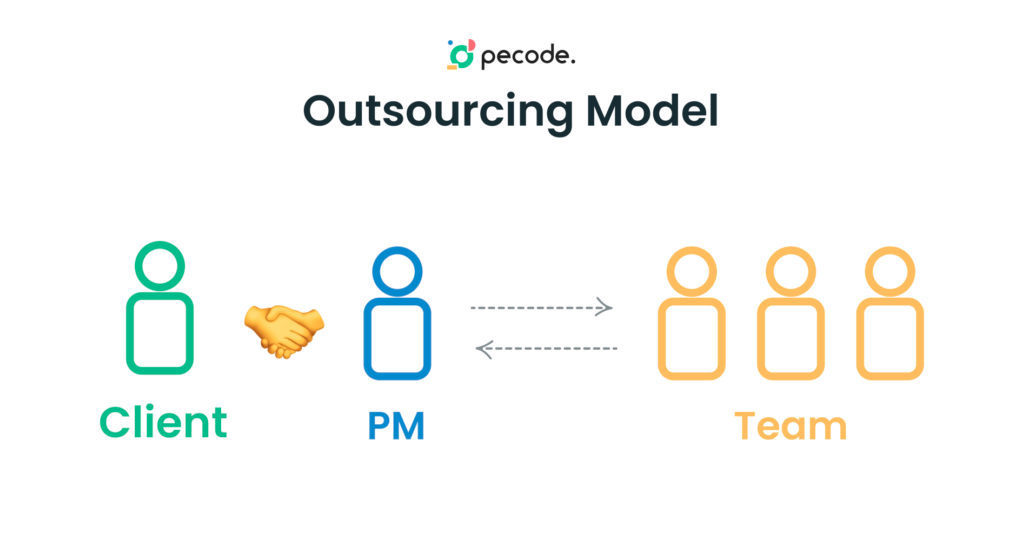One of the basic business principles says: In order to make more profit and optimize their workflow, companies seek a way to reduce operating costs.
This goal seems trivial and easy to understand, but the problem is not the principle itself. It’s all about the method you choose to implement this principle.
You may consider budget restrictions, niche narrowing, reduction of product functionality, or dismissal of employees as the proven ways to cut expenses. Still, experienced CEOs and managers prefer to use outsourcing or outstaffing when it comes to cost-reducing without efficiency drop.
However, what will be better for your company: outsourcing or outstaffing? Let’s dig in.
What is outsourcing
When you outsource your project, you pass all the processes to another team without full control over it. They are responsible for taking your project from zero to hero. The people who are working on your project can be also working with several others simultaneously. Of course, they work on the project remotely.

.
What is outstaffing
Outstaffing means “renting” a small number of experts to work for your project (usually on a remote basis), while they are still employees of your vendor. You’re responsible for the tasks and assignments, while the vendor is responsible for everything.

.
Pros and cons of outsourcing
Pros of outsourcing
+ The vendor bears all responsibility for product quality and on-time delivery.
+ No need to manage the work of the project team.
+ No need for additional hardware or software investments.
+ Flexible workflow with multiple people finding a better solution for every aspect.
+ Most of the problems can be solved without your involvement.
+ Human recourses aren’t your headache.
Cons of outsourcing
– You can’t often intervene in the development process
– Your financial expenses can rise due to unforeseen circumstances
– Outsource cost is higher than for outstaff.
– If you choose the wrong vendor, your product will possibly need a full redevelopment.
.
Pros and cons of outstaffing
Pros of outstaffing
+ A possibility to get ready-to-work experts directly into your team.
+ Full control over the development process, while the vendor is responsible for payroll and legal issues.
+ You have direct contacts of all your team and can manage them.
+ You can see and evaluate the expertise of outstaff workers.
+ Outstaffing is usually cheaper than outsourcing.
Cons of outstaffing
– There may be communication issues between your team and the outstaff team you hired.
– You bear all the responsibility.
– The price for their services can rise over time.
– The vendor can change the people working on your project.
What to choose?
Before choosing the cooperation model, the first thing you need to do is to analyze and evaluate your resources. Do you have enough of them to manage an external team without disrupting your internal processes?
If you do, then it comes to defining the project type and restrictions you have.
Outsourcing will benefit you when it comes to full-cycle product development. If you’re not a tech company (or you’re a tech company that wants to develop/adapt a product for new purposes and markets), it’s better to outsource your project. In that case, you will get an autonomous team that will make everything for you while you can focus on your industry issues.
The good part is that you don’t have to micromanage the team and focus on your needs. Outsourcing works both for start-ups/small companies, who don’t have many recourses to maintain a team, and big companies, who want to create a new product (or upgrade the one that exists) without making it a core task for the in-house team.
Outstaffing will be a perfect fit in case you established a stable project flow with proper and clear management, but you need to complete a specific part of product development without hiring additional people. Hiring and onboarding processes may last too long, because of possible talent shortages or strict deadlines. That’s when a ready-to-work outstaff team can save your project.
It will be working especially well when it comes to tasks that go beyond your tech stack and you need additional people to do it.
Finding an outsource or outstaff company
To put it simply, all you need is to follow this list:
1) Make sure the time zone of the vendor is suitable for you.
2) Ask for feedback from their customers.
3) Find out how they will be reporting to you.
4) Check if there are any law issues with payment and billing in their country.
5) In the age of NDA, ask them to describe their workflow in detail during the first call.
If the team suits you on all counts, congrats, it’s a match.
Speaking about the quality of outsource and outstaff development, in Pecode, we have experience working on outstaff and outsource projects. Our internal processes help us to be immediately involved in the projects and add enough resources for additional project needs. If you need a reliable and flexible partner — we are ready to cover your back. Text us via hello@pecodesoftware.com





